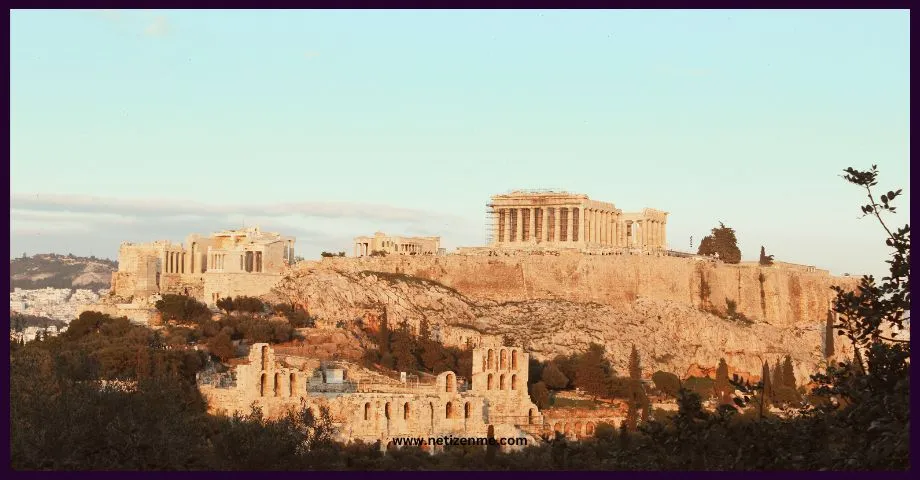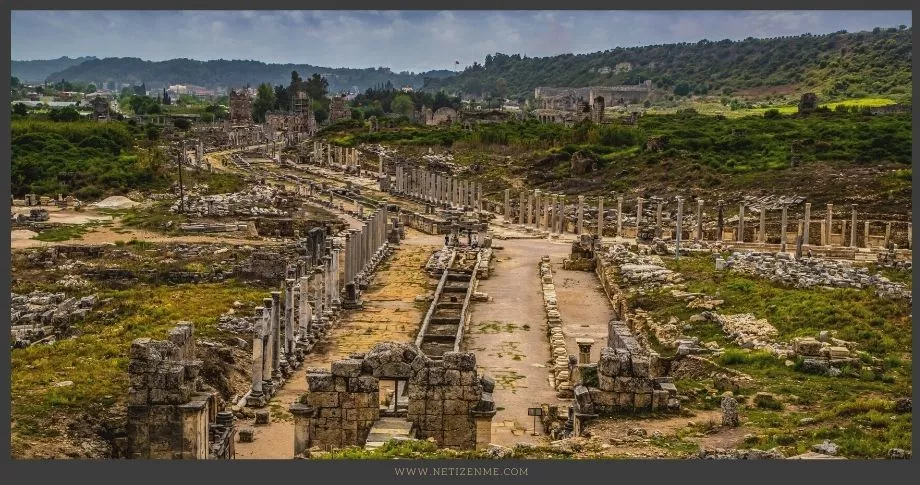The Parthenon and Maison Carrée stand as iconic examples of classical architecture, each representing the pinnacle of its respective civilization. In this essay, we will delve into the distinctive features of these structures, exploring their architectural elements, historical contexts, and cultural significance. Through a comparative analysis, we aim to provide a comparison and contrast the Parthenon to Maison Carree highlighting both the shared characteristics and unique attributes that define these masterpieces.
What is the Maison Carrée?
The Maison Carrée, meaning “square house” in French, stands as a remarkable testament to ancient Roman architecture and is located in Nîmes, southern France. This exceptionally well-preserved Roman temple is considered one of the finest examples within the former Roman Empire.
The Maison Carrée’s influence extends beyond its temporal and geographic boundaries, inspiring architectural masterpieces like the Église de la Madeleine in Paris and the Virginia State Capitol in the United States. In 2023, its cultural importance was further recognized as it joined the prestigious UNESCO World Heritage List.
What is the Parthenon?
The Parthenon, a venerable testament to ancient Greek architecture, once graced the Athenian Acropolis in Greece and was dedicated to the goddess Athena during the fifth century BC. Its significance extends beyond architectural prowess, with decorative sculptures considered pinnacle achievements of classical Greek art. As an enduring symbol of Ancient Greece, democracy, and Western civilization, the Parthenon stands as a historical icon.
Through its rich history, the Parthenon remains an enduring symbol of cultural heritage and a testament to the resilience of ancient Greek craftsmanship.
Comparison and Contrast the Parthenon to Maison Carree
While the Parthenon and Maison Carrée share classical origins, their architectural nuances, purposes, and cultural contexts reveal fascinating points of divergence.
I. Architectural Elements
The Parthenon
- Doric architectural style
- Use of optical refinements
- Pedimental sculptures depicting Greek mythology
The Parthenon, an exemplary embodiment of the Doric architectural style, showcases the essence of ancient Greek craftsmanship. Employing the Doric order, characterized by sturdy columns and a simple, harmonious design, the Parthenon stands as a testament to classical architectural principles. One notable feature is the use of optical refinements, where columns and other elements subtly deviate from strict mathematical alignment to create an illusion of perfect symmetry when viewed from a distance. This ingenious technique exemplifies the meticulous planning and attention to detail employed by ancient Greek architects.
Adding a narrative dimension to its grandeur, the Parthenon features pedimental sculptures that intricately depict Greek mythology. These sculptural reliefs, positioned on the triangular pediments at each end of the temple, narrate mythological tales and showcase the artistic prowess of the ancient Greeks. The combination of Doric architecture and mythological sculptures creates a harmonious blend that reflects the cultural and artistic ideals of ancient Greece.
Maison Carrée
- Corinthian architectural style
- Precision in proportions and symmetry
- Lack of external sculptural embellishments
In contrast, the Maison Carrée exemplifies the Corinthian architectural style, characterized by its more ornate and decorative features. While the Doric order of the Parthenon emphasizes simplicity, the Maison Carrée embraces the Corinthian order, marked by slender fluted columns topped with intricately carved capitals adorned with acanthus leaves. This Corinthian style, known for its precision in proportions and symmetry, imparts a sense of elegance and refinement to the Maison Carrée.
Distinctively, the Maison Carrée lacks the external sculptural embellishments found on the Parthenon. Instead of intricate narrative reliefs, the focus is on the purity of architectural form and proportion. The precision in design, coupled with the emphasis on symmetry, highlights the Corinthian order’s aesthetic appeal. The Maison Carrée’s architectural elegance lies in its restraint, relying on the beauty of proportion rather than elaborate sculptural narratives.
II. Historical Context
The Parthenon
- Built in the 5th century BCE on the Acropolis of Athens
- Dedicated to the goddess Athena
- Functioned as a temple and treasury
The Parthenon, a quintessential marvel of ancient architecture, was constructed in the 5th century BCE atop the Acropolis of Athens. This monumental undertaking took place during the peak of the Delian League’s power, with construction beginning in 447 BCE and completed in 438 BCE. Dedicated to the goddess Athena, the Parthenon held profound religious significance as a temple. Beyond its religious function, it also served as the city treasury, underlining its dual role in both civic and religious affairs. The construction of the Parthenon was a symbol of gratitude for the Hellenic victory over Persian invaders during the Greco-Persian Wars, solidifying its historical importance in the context of ancient Athens.
In the centuries that followed, the Parthenon transformed, serving as a Christian church dedicated to the Virgin Mary in the 6th century AD and later converted into a mosque after the Ottoman conquest in the mid-fifteenth century. The Parthenon faced significant damage during the Morean War in 1687 when a Venetian bomb struck the structure. This led to the conversion of the temple into a munitions depot by the Ottomans, resulting in a catastrophic explosion. The aftermath of this event, combined with the removal of surviving sculptures, known as the Elgin Marbles, by the 7th Earl of Elgin in the early 19th century, contributed to the Parthenon’s complex historical narrative. Replacing the older temple of Athena, known as the Pre-Parthenon or Older Parthenon, which fell victim to the Persian invasion of 480 BC, the Parthenon has become a focal point of restoration efforts since 1975. Various large-scale projects aim to preserve its artifacts and ensure the structural integrity of this architectural marvel.
Maison Carrée
- Constructed in the 1st century BCE in Nîmes, France
- Dedicated to Gaius Caesar and Lucius Caesar
- Served as a temple in Roman times and transformed into a church and a municipal building later
In contrast, the Maison Carrée has its roots in the 1st century BCE in Nîmes, France. This Roman temple, constructed during around 4–7 AD, the reign of Augustus, stands as one of the best-preserved examples of Roman architecture. Originally dedicated to Gaius Caesar and Lucius Caesar, the grandsons and adopted heirs of Augustus, it served as a caesareum, a temple for the Imperial cult. Despite the removal of the original dedication inscription in medieval times, meticulous reconstruction efforts in the 18th century, led by local scholar Jean-François Séguier, revived the temple’s historical significance. Over time, the Maison Carrée transformed, reflecting the evolving cultural landscape. In subsequent eras, it served various functions, including its role as a Christian church dedicated to the Virgin Mary and later repurposed as a municipal building.
III. Cultural Significance
The Parthenon
- Symbol of ancient Greek democracy and power
- Inspirational in the Neoclassical movement
- Houses significant classical art and artifacts
The Parthenon stands as an iconic symbol of ancient Greek democracy and power. Perched on the Acropolis of Athens, it represents the pinnacle of Athenian achievement during the Golden Age. Beyond its historical role, the Parthenon’s cultural significance extends to its influence on the Neoclassical movement. The temple’s Doric architectural style and pedimental sculptures depicting Greek mythology-inspired a resurgence of classical aesthetics in the 18th and 19th centuries. Artists and architects looked to the Parthenon as a timeless embodiment of classical ideals, shaping the Neoclassical movement and influencing structures like the Église de la Madeleine in Paris. Additionally, the Parthenon serves as a custodian of significant classical art and artifacts, reflecting the cultural and artistic achievements of ancient Greece.
Maison Carrée
- Represents Roman imperial grandeur
- Influenced later Neoclassical architecture in France
- Preserved as one of the best-preserved Roman temples
In contrast, Maison Carrée embodies the grandeur of Roman imperial architecture. Serving as a temple dedicated to the imperial heirs Gaius Caesar and Lucius Caesar, it stands as a testament to Roman authority and cultural refinement. The Corinthian architectural style, precision in proportions, and symmetry showcase the meticulous craftsmanship of Roman builders. Maison Carrée’s cultural significance extends beyond its original Roman context, influencing later Neoclassical architecture in France. The temple’s enduring legacy is underscored by its designation as one of the best-preserved Roman temples, preserving the architectural and cultural heritage of ancient Rome. Maison Carrée’s role in shaping architectural aesthetics transcends its temporal origins, contributing to the continuity of classical influence in different cultural and historical contexts.
Comparison and contrast the Parthenon to Maison Carree
In conclusion, the Parthenon and Maison Carrée, although rooted in classical architecture, manifest distinct characteristics reflective of their respective civilizations. While the Parthenon exudes the grandeur of ancient Greek democracy, the Maison Carrée stands as a testament to Roman imperial might. Both structures, with their unique architectural elements and cultural significance, contribute significantly to the rich tapestry of classical art and heritage.
Comparison of the Parthenon and the Pantheon
Sources used for Comparison and contrast the Parthenon to Maison Carree:
Museum, B. (n.d.). » The Parthenon, Athens. https://smarthistory.org/the-parthenon-athens/
Neil, B. (n.d.). Blowing up the Parthenon: the power of a symbol. The Conversation. https://theconversation.com/blowing-up-the-parthenon-the-power-of-a-symbol-100826
The Maison Carrée: a Roman Architectural Masterpiece – Google Arts & Culture. (n.d.). Google Arts & Culture. https://artsandculture.google.com/story/the-maison-carr%C3%A9e-a-roman-architectural-masterpiece-ciap/tQUBY17jHp8CLw?hl=en
UNESCO World Heritage Centre. (n.d.). The Maison Carrée of Nîmes. https://whc.unesco.org/en/list/1569/
This article is written by:
Our professional writers and editors are passionate about sharing high-quality information and insights with our audience. We conduct diligent research, maintain fact-checking protocols, and prioritize accuracy and integrity to the best of our capacity.
You can cite our articles under the author name "Netizenme"




